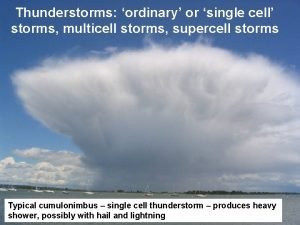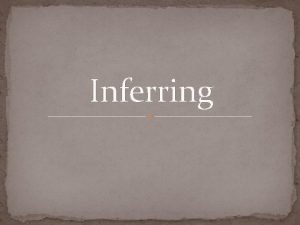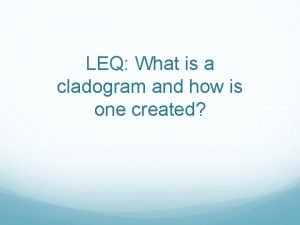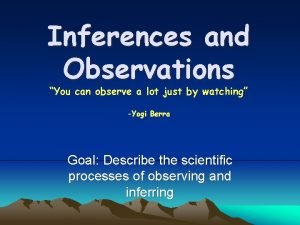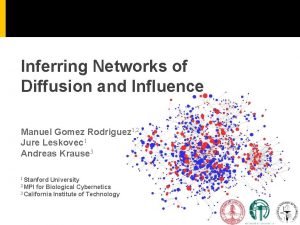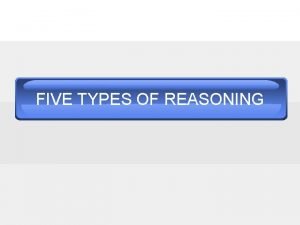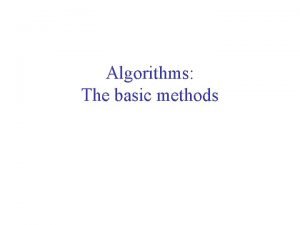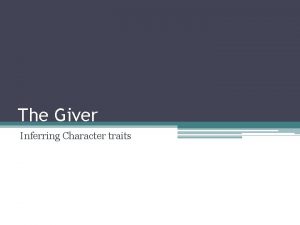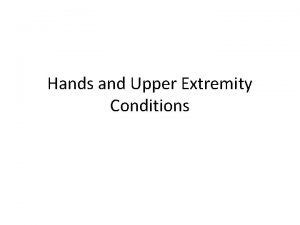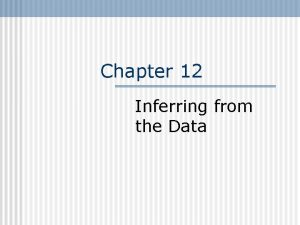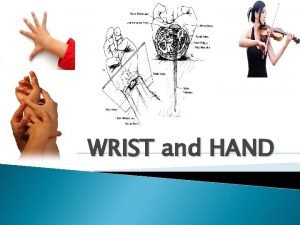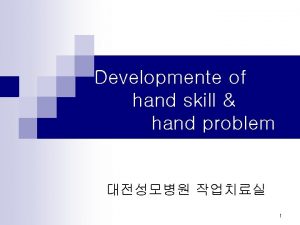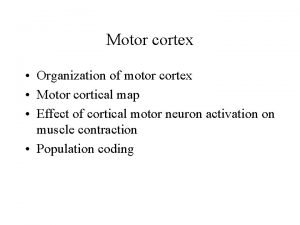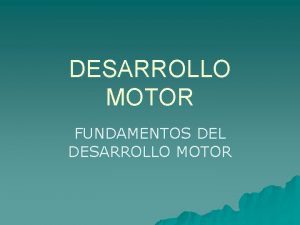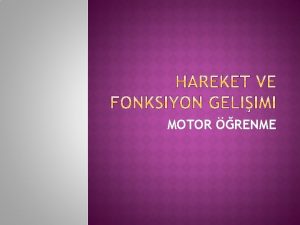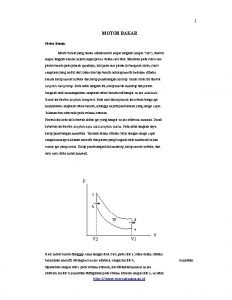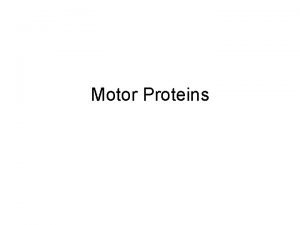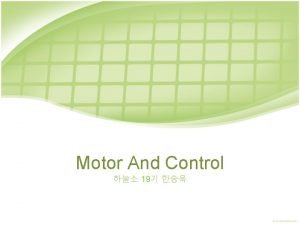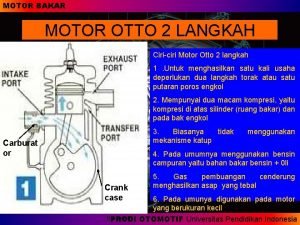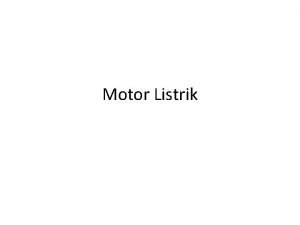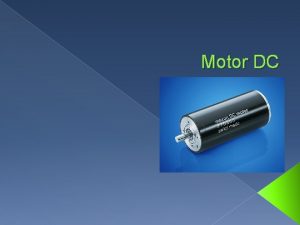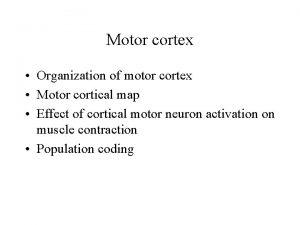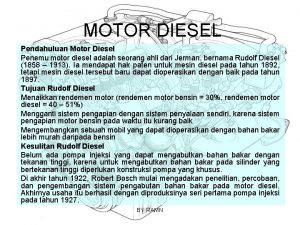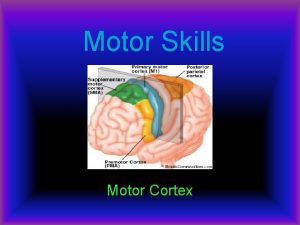Inferring Hand Motion from MultiCell Recordings in Motor






















- Slides: 22

Inferring Hand Motion from Multi-Cell Recordings in Motor Cortex using a Kalman Filter Wei Wu*, Michael Black†, Yun Gao*, Elie Bienenstock*§, Mijail Serruya§, Ammar Shaikhouni§, Carlos Vargas§†, John Donoghue§ Brown University *Applied Mathematics †Computer Science §Neuroscience

Outline • • Introduction Kalman Filter Model and its Algorithm Experimental Result Analysis • Optimal Time Lag • Comparison with Linear Filter • Conclusion

Goals off-line data processing neural Firing signals rates observations Kalman mathematical Filter algorithm inference/decoding neural reconstruction hand position

Goals on-line direct neural control Firing rates observations Kalman Filter inference/decoding visual feedback neural reconstruction

Related Work • Georgopoulos et al. (1986) Population Vector • Taylor et al. (2002) • Warland et al. (1997) • Wessberg et al. (2000) • Brown et al. (1998) Linear filter, ANN Kalman filter • Serruya et al. (2002) • Gao et al. (2002) Linear filter Particle filter

Multi-electrode Array Implant for Spike Timing Recordings Utah Array (4 x 4 mm) 100 electrodes, 400 mm separation 80µV 1 ms spike wave form

Target Tracking Task Motions: fast, unconstrained Data (training 3. 5 min, testing 1 min): • Position (Velocity, Acceleration) • Firing rate (42 cells, nonoverlapping 70 ms bins)

Mathematical Model • has a sound probabilistic framework • makes explicit assumptions about the data and • • noise indicates the uncertainty of the estimate requires a small amount of “training” data provides on-line estimation of hand position with short delay(within 200 ms) has more accurate estimation than the standard linear filter does

Kalman Filter Model system state vector Measurement Equation: firing rate vector System Equation: 42 X 6 matrix 6 X 6 matrix 42 X 42 matrix 6 X 6 matrix

System Encoding by Training Data Centralize the training data, such that

Kalman Filter Algorithm Time Update Prior estimate Error covariance Measurement Update Posterior estimate Error covariance Kalman gain Welch and Bishop 2002

Reconstruction on Test Data

Optimal Lag Measurement Equation Changing it in two ways: • Uniform: lag j time steps (1 time step = 70 ms) • Non-uniform: lag time steps

Optimal Lag on Test Data Methods CC MSE (x , y ) (0. 77, 0. 91) (0. 79, 0. 93) (0. 81, 0. 89) (0. 76, 0. 82) 6. 96 6. 67 6. 09 6. 98 8. 91 Kalman(non-uniform) (0. 82, 0. 93) 5. 24 Kalman(0 ms lag) Kalman(70 ms lag) Kalman(140 ms lag) Kalman(210 ms lag) Kalman(280 ms lag)

Linear Filter learned “filter” constant offset hand position vector of firing rates for 42 cells over 20 bins (1. 4 sec) Simple regression model, fast decoding, reasonable reconstruction No explicitly probabilistic model, No uncertainty estimation, slow encoding

Linear Reconstruction Methods CC (x , y ) Kalman(140 ms lag) (0. 81, 0. 93) Linear filter (0. 76, 0. 92) MSE 6. 09 8. 30

Conclusion Kalman Filter: • has sound probabilistic framework, explicit assumptions, and uncertainty in estimation • is more accurate than linear filter in estimation • provides efficient filtering algorithm • shows better reconstruction with time lag analysis

Future Work • Exploring Poisson model for spiking activity • • • instead of Gaussian Exploring the non-linear system model Further comparison with population vector methods (Taylor et al, 2002) and particle filtering techniques (Gao et al, 2002) on-line experiment of direct neural control using the Kalman filter

Thanks David Mumford Applied Mathematics Juliana Dushanova Neuroscience Lauren Lennox Neuroscience Matthew Fellows Neuroscience Liam Paninski NYU Neuroscience and Mathematics Nicholas Hatsopoulos U. Chicago Comp. Neuroscience Support: National Science Foundation Keck Foundation National Institutes of Health

Firing rate gives better estimation

Linear filters built on-line Mijail Serruya target Neural control

Goals • (off-line) reconstruct monkey’s hand trajectory • • from its neural activity (on-line) control cursor movement from monkey’s neural activity (ultimate) provide control of prosthetic devices for severely disabled humans
 Cumulus stage
Cumulus stage Multicell thunderstorms
Multicell thunderstorms Freepbx system recordings location
Freepbx system recordings location Colors by halsey lyrics
Colors by halsey lyrics Making inferences reading between the lines
Making inferences reading between the lines Lancelet lamprey tuna salamander turtle leopard cladogram
Lancelet lamprey tuna salamander turtle leopard cladogram What is inferring
What is inferring The grass is wet observation or inference
The grass is wet observation or inference Inferring networks of diffusion and influence
Inferring networks of diffusion and influence What is inference
What is inference Inferring
Inferring Inferring rudimentary rules
Inferring rudimentary rules What is the tone of a story
What is the tone of a story Character traits of the giver
Character traits of the giver Ac motor vs dc motor
Ac motor vs dc motor Ee 216
Ee 216 A motor unit consists of:
A motor unit consists of: Three phase synchronous generator
Three phase synchronous generator Use of synchronous motor
Use of synchronous motor Ape hand vs hand of benediction
Ape hand vs hand of benediction Father mother sister brother hand in hand with one another
Father mother sister brother hand in hand with one another Telling the time
Telling the time Handsoft
Handsoft
